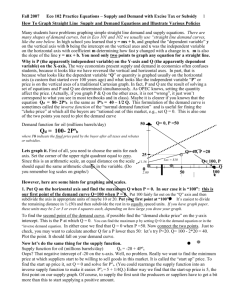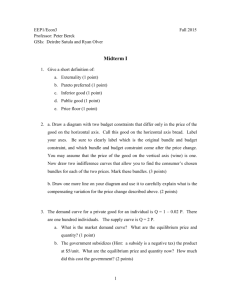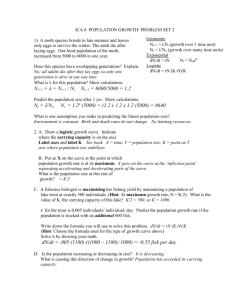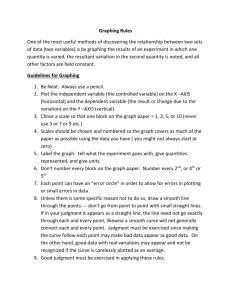How To Graph Straight Line Supply and Demand Equations and
advertisement
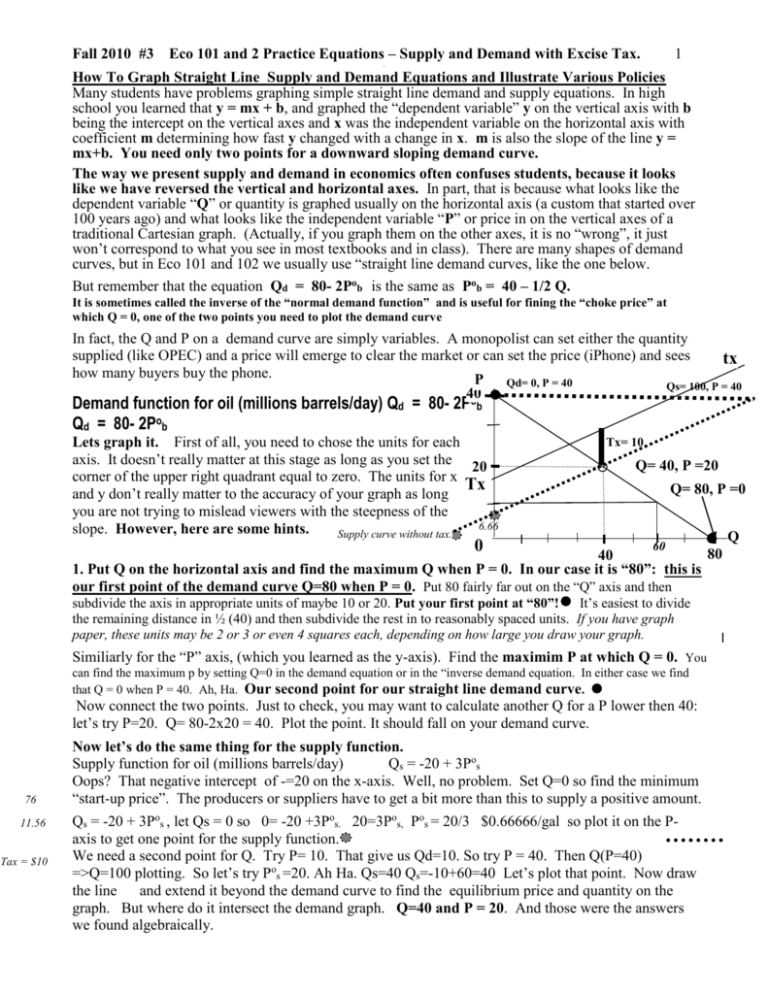
Fall 2010 #3 Eco 101 and 2 Practice Equations – Supply and Demand with Excise Tax. 1 . How To Graph Straight Line Supply and Demand Equations and Illustrate Various Policies Many students have problems graphing simple straight line demand and supply equations. In high school you learned that y = mx + b, and graphed the “dependent variable” y on the vertical axis with b being the intercept on the vertical axes and x was the independent variable on the horizontal axis with coefficient m determining how fast y changed with a change in x. m is also the slope of the line y = mx+b. You need only two points for a downward sloping demand curve. The way we present supply and demand in economics often confuses students, because it looks like we have reversed the vertical and horizontal axes. In part, that is because what looks like the dependent variable “Q” or quantity is graphed usually on the horizontal axis (a custom that started over 100 years ago) and what looks like the independent variable “P” or price in on the vertical axes of a traditional Cartesian graph. (Actually, if you graph them on the other axes, it is no “wrong”, it just won’t correspond to what you see in most textbooks and in class). There are many shapes of demand curves, but in Eco 101 and 102 we usually use “straight line demand curves, like the one below. But remember that the equation Qd = 80- 2Pob is the same as Pob = 40 – 1/2 Q. It is sometimes called the inverse of the “normal demand function” and is useful for fining the “choke price” at which Q = 0, one of the two points you need to plot the demand curve In fact, the Q and P on a demand curve are simply variables. A monopolist can set either the quantity supplied (like OPEC) and a price will emerge to clear the market or can set the price (iPhone) and sees tx how many buyers buy the phone. P Qd= 0, P = 40 Qs= 100, P = 40 40 o Demand function for oil (millions barrels/day) Qd = 80- 2P Qd = 80- 2Pob b Lets graph it. First of all, you need to chose the units for each axis. It doesn’t really matter at this stage as long as you set the 20 corner of the upper right quadrant equal to zero. The units for x Tx and y don’t really matter to the accuracy of your graph as long you are not trying to mislead viewers with the steepness of the 6.66 slope. However, here are some hints. Supply curve without tax. 0 Tx= 10 Q= 40, P =20 Q= 80, P =0 60 80 40 1. Put Q on the horizontal axis and find the maximum Q when P = 0. In our case it is “80”: this is our first point of the demand curve Q=80 when P = 0. Put 80 fairly far out on the “Q” axis and then subdivide the axis in appropriate units of maybe 10 or 20. Put your first point at “80”! It’s easiest to divide the remaining distance in ½ (40) and then subdivide the rest in to reasonably spaced units. If you have graph paper, these units may be 2 or 3 or even 4 squares each, depending on how large you draw your graph. Similiarly for the “P” axis, (which you learned as the y-axis). Find the maximim P at which Q = 0. You can find the maximum p by setting Q=0 in the demand equation or in the “inverse demand equation. In either case we find that Q = 0 when P = 40. Ah, Ha. Our second point for our straight line demand curve. Now connect the two points. Just to check, you may want to calculate another Q for a P lower then 40: let’s try P=20. Q= 80-2x20 = 40. Plot the point. It should fall on your demand curve. 76 11.56 Tax = $10 Now let’s do the same thing for the supply function. Supply function for oil (millions barrels/day) Qs = -20 + 3Pos Oops? That negative intercept of -=20 on the x-axis. Well, no problem. Set Q=0 so find the minimum “start-up price”. The producers or suppliers have to get a bit more than this to supply a positive amount. Qs = -20 + 3Pos , let Qs = 0 so 0= -20 +3Pos. 20=3Pos, Pos = 20/3 $0.66666/gal so plot it on the Paxis to get one point for the supply function. We need a second point for Q. Try P= 10. That give us Qd=10. So try P = 40. Then Q(P=40) =>Q=100 plotting. So let’s try Pos =20. Ah Ha. Qs=40 Qs=-10+60=40 Let’s plot that point. Now draw the line and extend it beyond the demand curve to find the equilibrium price and quantity on the graph. But where do it intersect the demand graph. Q=40 and P = 20. And those were the answers we found algebraically. Q Adding a $10 Excise Taxes on each unit of oil. How much will the price rise? 10? It’s easy to see on the graph above. Add $10 to |$6.666 when Q equals 0 and $10 to $20.00 when Q =40 and $10 to $40.00 when Q= 100. Connect the points. This is now the supplier’s NEW willingness to supply because they have get a high enough price to pay the $10.00 tax per gal. What is left over is used to cover their marginal costs. It looks like the demand curves intersects the new supply curve at about where Ptb = $24 and at the higher price the buyer buy less. It looks like Qd = 28 It’s clear that the price did not go up $10. Who paid the rest of it. The lower cost producers who could product at $14 and were still in business, paid about $6 of it. The higher cost producers simply had to stop production or lose money. We can find out the exact amount using algebra. Let Pb be the price paid by the buyers. Let Ps be the price which the sellers receive after paying the tax. So the relationship between the two prices is Pb= Ps+Tx or the same thing Pb-Tx = Ps. Now the buyer are only interested in what they have to pay for the oil and the suppliers base the supply decisions on how much money they get for the oil after paying the tax. Soooooooo Qd = 80 – 2Pb Qs = -20 + 3Ps = -20 + 3(Pb-Tx), and since the tax = $10, Qs=-20 + 3(Pb-$10) => Qs =-20 + 3Pb-3*$10 =-20 + 3Pb-30 Since Qd(Pb) must equal Qs(Ps) in equilibrium, we have 80-2Pb = -20 +3Pb - $30 => 130 = 5Pb, so Pb =26 and Ps = 16 and Q = 80-2*26 = 80 – 52 = 28 Remember , the buyer decides how much to buy based on the price they actually pay (including tax or subsidy or rebate or whatever affects the final amount they pay). This is Pb. The amount they are willing to pay as they buy more go down because of the law of diminishing marginal utility. And the seller decides how much to produce and sell based on the total net amount that actually receive after paying excise or sales taxes or getting a per unit subsidy or rebate or whatever affects the final amount they get to pay for the marginal cost of the product they are selling including normal profit.. This is Ps. For the purpose of teaching supply and demand initial we usually assume that the supply curve is upward sloping because of rising marginal costs. This is reasonable in the short run because capital and even land is fixed, so the law of diminishing marginal product makes it more and more expensive to supply more units. Also remember the we cannot force buyer to buy more than they want at Pb, and we cannot force sellers to offer more on the market than they want to at Ps, at least in competitive markets with many buyers and sellers, etc. This is important with price supports (minimum wage) and price ceilings (rent control, taxi fares, bridge tolls at rush hour) Do these problems and hand them in on Thursday. Show your work. Practice problems: Solve algebraically and then graph and label them all. 1. Qd = 100- 2Pob Qs = -80 + 4Pob 2. $10 unit-tax: Answer: 3. $10 unit-subsidy: Ptb = 36.66 Should intersect at P= 30 and Q= 40. Pts = 26.66 Answer: Ptb = 23.33 Qd = Qs = 26.66 Pts = 33.33 Qd = Qs = 53.33 4. Price floor or support in original problem 1. Psupport = $40: Qd= 20 Qs= 80 Excess supply = 60 units Be sure to graph it and show price support.. 5. Price ceiling at Pceiling = $22: Qd= 56 Qs= 8 Excess demand = 46 units. What problems do you see in this market. 6. Fixed quantity offered to this market: De Beers Diamonds: Q=10. What is market clearing price. Graph it. 7. Unlimited imports at $20. What happens to this industry?

